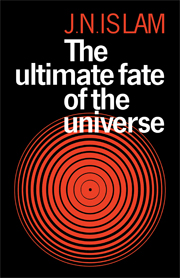Book contents
- Frontmatter
- Contents
- Preface
- Dedication
- Note on some conventions
- 1 Introduction
- 2 Our Galaxy
- 3 The large-scale structure of the universe
- 4 Elementary particles – a preliminary look
- 5 Is the universe open or closed?
- 6 Three ways for a star to die
- 7 Black holes and quasars
- 8 Galactic and supergalactic black holes
- 9 A black hole is not forever
- 10 Slow and subtle changes
- 11 Future of life and civilization
- 12 A collapsing universe
- 13 The steady state theory
- 14 The stability of the proton
- 15 Epilogue
- Glossary
- Selected bibliography
- Index
3 - The large-scale structure of the universe
Published online by Cambridge University Press: 06 July 2010
- Frontmatter
- Contents
- Preface
- Dedication
- Note on some conventions
- 1 Introduction
- 2 Our Galaxy
- 3 The large-scale structure of the universe
- 4 Elementary particles – a preliminary look
- 5 Is the universe open or closed?
- 6 Three ways for a star to die
- 7 Black holes and quasars
- 8 Galactic and supergalactic black holes
- 9 A black hole is not forever
- 10 Slow and subtle changes
- 11 Future of life and civilization
- 12 A collapsing universe
- 13 The steady state theory
- 14 The stability of the proton
- 15 Epilogue
- Glossary
- Selected bibliography
- Index
Summary
Other galaxies
Many of the objects in Messier's catalogue have turned out to be systems outside our Galaxy. One of these is the Andromeda nebula (Fig. 3.1), visible to the naked eye on a clear night as a hazy patch in the constellation Andromeda. In ad 964 the Persian astronomer Abdurrahman Al-Sufi mentioned it in his Book of the fixed stars, calling it ‘a little cloud’. The Andromeda nebula has turned out to be a spiral galaxy somewhat like our own, and a close neighbour of our Galaxy. In the late nineteenth and early twentieth centuries there was a great controversy about the nature of the nebulae listed by Messier, the Herschels and Dreyer. There was one school of thought which held the view that some of these nebulae were extragalactic, i.e. systems outside our Galaxy. In fact the original suggestion that some nebulae might be extragalactic seems to have been made by the German philosopher Immanuel Kant (1724–1804). Taking up Wright's theory of the Milky Way, in 1755 in his Universal natural history and theory of the heavens, he suggested that some nebulae are in fact circular discs somewhat like our Galaxy, and they are faint because they are so far away.
The controversy was finally settled in the 1920s and 1930s mainly by the American astronomer Edwin Powell Hubble (1889–1953) who demonstrated beyond reasonable doubt that most of the nebulae are indeed extragalactic.
- Type
- Chapter
- Information
- The Ultimate Fate of the Universe , pp. 13 - 37Publisher: Cambridge University PressPrint publication year: 1983



